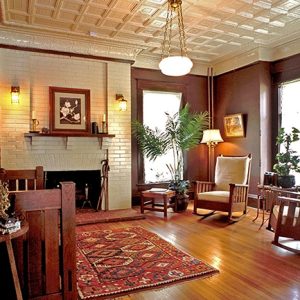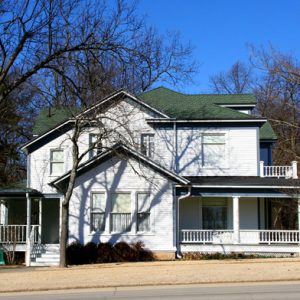calsfoundation@cals.org
Hemingway-Pfeiffer Museum
The Hemingway-Pfeiffer Museum and Educational Center, located at 1021 West Cherry Street in Piggott (Clay County), opened on July 4, 1999. The museum and educational center is designed to contribute to the understanding of the 1920s and 1930s by focusing on the internationally connected Pfeiffer family of Piggott and their son-in-law, Ernest Hemingway. Hemingway was awarded the Pulitzer Prize for Literature in 1953 for the novel The Old Man and the Sea and was named Nobel Laureate in Literature in 1954 for his overall contribution to writing.
The museum includes the Pfeiffer-Janes House and the Hemingway Barn-Studio. W. D. “Buck” Templeton built both structures in 1910. Paul Pfeiffer bought the house and barn in 1913 and moved his family to Piggott from St. Louis, Missouri. Pfeiffer died in 1944, and Mary Pfeiffer continued to live in the house until her death in 1950. The Tom Janes family bought the house in 1950 and owned it until Arkansas State University purchased the property in 1997. Dr. Ruth Hawkins instigated the purchase by ASU as the northern anchor and visitor’s center of the Crowley’s Ridge Parkway, which was the first National Scenic Byway in Arkansas. Both the house and barn were placed on the National Register of Historic Places in 1982.
Hemingway married Pauline Pfeiffer in Paris, France, on May 10, 1927, after he divorced his first wife. Pfeiffer, the daughter of Paul and Mary Pfeiffer, was in Paris on assignment for Vogue magazine.
In the spring of 1928, Hemingway and his wife, Pauline, came to Piggott for him to meet his in-laws and to await the birth of their first child. This was Hemingway’s first visit to Piggott. In the following years, he often spent time in Piggott hunting quail, writing, and spending time with his in-laws. While they were in Piggott, Hemingway claimed the small barn as his private place to write; he was working on the novel A Farewell to Arms. Returning to Piggott at the end of July, after the birth of his son Patrick, Hemingway found it too hot to work on his novel. He went west to write, and fish, in a cooler climate.
In 1932, Hemingway brought his wife and three children, a nine-year-old son from his first marriage and his two sons with Pauline, to Piggott for one of their winter holiday visits. One of his short stories, “A Day’s Wait,” was written about this visit and published in a short story collection the following summer. Prior to this visit, his sister-in-law, Virginia Pfeiffer, had remodeled the barn loft to create a studio for Hemingway. A fire in the studio during that visit destroyed many of Hemingway’s belongings. Evidence of the fire is visible on an outside wall of the barn-studio. The structure was repaired, and a new flue was built so that Hemingway could continue to use the space.
Areas of emphasis for the museum include examining literature of the 1930s through the works of Ernest Hemingway and other writers of his era; providing insight into the impact of Piggott and the Pfeiffer family on Ernest Hemingway and his writing; examining world events from the perspective of a family with global connections; examining the development of northeast Arkansas during the 1930s, including the establishment of drainage districts, development of roads, growth of agriculture, etc.; providing educational programs and tours for elementary, secondary and adult students; offering seminars, conferences, workshops, day camps, retreats, credit and non-credit classes; and the encouraging of creative writing.
The museum presents the Pfeiffer-Janes House and the Hemingway Barn-Studio as they would have appeared during the time Hemingway visited there. Most of the furnishings, including many Stickley pieces, were owned by Paul and Mary Pfeiffer and were in use when Hemingway was in Piggott.
For additional information:
Bowden, Bill. “Author Put Piggott over Paris in 1933.” Arkansas Democrat-Gazette, April 4, 2021, pp. 1A, 8A.
———. “Cache Illuminates Hemingway’s Snub of Film.” Arkansas Democrat-Gazette, October 3, 2022, 1B, 3B.
“Ernest Hemingway.” Special issue. Arkansas Review: A Journal of Delta Studies 30 (July 1999).
Hawkins, Ruth A. Unbelievable Happiness and Final Sorrow: The Hemingway-Pfeiffer Marriage. Fayetteville: University of Arkansas Press, 2012.
Hemingway-Pfeiffer Museum and Educational Center. http://hemingway.astate.edu (accessed July 6, 2023).
Hotchner, A. E. Hemingway in Love: His Own Story. New York: St. Martin’s Press, 2015.
Long, Adam, ed. “Hemingway-Pfeiffer Connections: The Museum Turns 15.” Special issue. Arkansas Review: A Journal of Delta Studies 45 (August 2014).
Nixon, Jennifer. “Pfeiffers Befriended Piggott, Hemingway Gave It Fame.” Arkansas Democrat-Gazette, April 8, 2007, p. 3H.
“Pfeiffer House and Carriage House.” National Register of Historic Places nomination form. On file at Arkansas Historic Preservation Program, Little Rock, Arkansas.
Schnedler, Jack. “Hemingway Museum Sees Surge in Tourism.” Arkansas Democrat-Gazette, June 20, 2021, pp. 1E, 6E. Online at https://www.arkansasonline.com/news/2021/jul/20/hemingway-museum-sees-surge-in-tourism/ (accessed July 6, 2023).
Deanna Dismukes
Hemingway-Pfeiffer Museum & Educational Center
 Divergent Prosperity and the Arc of Reform, 1968–2022
Divergent Prosperity and the Arc of Reform, 1968–2022 Historic Preservation
Historic Preservation Ruth Hawkins
Ruth Hawkins  Hemingway-Pfeiffer Museum Interior
Hemingway-Pfeiffer Museum Interior  Hemingway-Pfeiffer Museum
Hemingway-Pfeiffer Museum  Hemingway-Pfeiffer Museum
Hemingway-Pfeiffer Museum  Hemingway-Pfeiffer Museum Educational Center
Hemingway-Pfeiffer Museum Educational Center 




Comments
No comments on this entry yet.